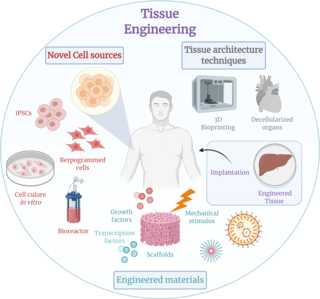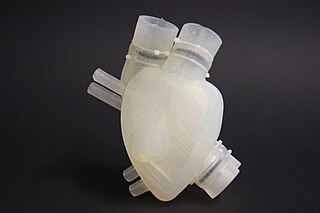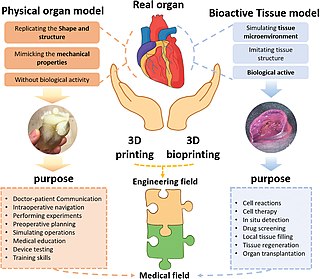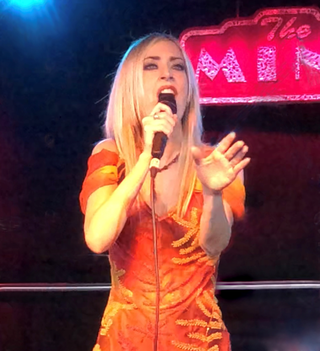Maximum life span is a measure of the maximum amount of time one or more members of a population have been observed to survive between birth and death. The term can also denote an estimate of the maximum amount of time that a member of a given species could survive between birth and death, provided circumstances that are optimal to that member's longevity.

Tissue engineering is a biomedical engineering discipline that uses a combination of cells, engineering, materials methods, and suitable biochemical and physicochemical factors to restore, maintain, improve, or replace different types of biological tissues. Tissue engineering often involves the use of cells placed on tissue scaffolds in the formation of new viable tissue for a medical purpose, but is not limited to applications involving cells and tissue scaffolds. While it was once categorized as a sub-field of biomaterials, having grown in scope and importance, it can is considered as a field of its own.

Aubrey David Nicholas Jasper de Grey is an English biomedical gerontologist. He is the author of The Mitochondrial Free Radical Theory of Aging (1999) and co-author of Ending Aging (2007). De Grey is known for his view that medical technology may enable human beings alive today not to die from age-related causes. As an amateur mathematician, he has contributed to the study of the Hadwiger–Nelson problem in geometric graph theory, making the first progress on the problem in over 60 years.
Strategies for engineered negligible senescence (SENS) is a range of proposed regenerative medical therapies, either planned or currently in development, for the periodic repair of all age-related damage to human tissue. These therapies have the ultimate aim of maintaining a state of negligible senescence in patients and postponing age-associated disease. SENS was first defined by British biogerontologist Aubrey de Grey. Many mainstream scientists believe that it is a fringe theory. De Grey later highlighted similarities and differences of SENS to subsequent categorization systems of the biology of aging, such as the highly influential Hallmarks of Aging published in 2013.

Organ printing utilizes techniques similar to conventional 3D printing where a computer model is fed into a printer that lays down successive layers of plastics or wax until a 3D object is produced. In the case of organ printing, the material being used by the printer is a biocompatible plastic. The biocompatible plastic forms a scaffold that acts as the skeleton for the organ that is being printed. As the plastic is being laid down, it is also seeded with human cells from the patient's organ that is being printed for. After printing, the organ is transferred to an incubation chamber to give the cells time to grow. After a sufficient amount of time, the organ is implanted into the patient.
Gregory Stock is an American biophysicist, best-selling author, biotech entrepreneur, and the former director of the Program on Medicine, Technology and Society at UCLA’s School of Medicine. His interests lie in the scientific and evolutionary as well as ethical, social and political implications of today's revolutions in the life sciences and in information technology and computers.
Following is a list of topics related to life extension:
The following outline is provided as an overview of and topical guide to life extension:

Anthony Atala is an American bioengineer, urologist, and pediatric surgeon. He is the W.H. Boyce professor of urology, the founding director of the Wake Forest Institute for Regenerative Medicine, and the chair of the Department of Urology at Wake Forest School of Medicine in North Carolina. His work focuses on the science of regenerative medicine: "a practice that aims to refurbish diseased or damaged tissue using the body's own healthy cells".

David Gobel is an American philanthropist, entrepreneur, inventor, and futurist. He is co-founder and CEO of the Methuselah Foundation, CEO of the Methuselah Fund, and one of the first to publicly advance the idea of longevity escape velocity, even before this term was formulated.
The SENS Research Foundation is a non-profit organization that does research programs and public relations work for the application of regenerative medicine to aging. It was founded in 2009, located in Mountain View, California, USA. The organization publishes its reports annually.

Three dimensional (3D) bioprinting is the utilization of 3D printing–like techniques to combine cells, growth factors, bio-inks, and biomaterials to fabricate functional structures that were traditionally used for tissue engineering applications but in recent times have seen increased interest in other applications such as biosensing, and environmental remediation. Generally, 3D bioprinting utilizes a layer-by-layer method to deposit materials known as bio-inks to create tissue-like structures that are later used in various medical and tissue engineering fields. 3D bioprinting covers a broad range of bioprinting techniques and biomaterials. Currently, bioprinting can be used to print tissue and organ models to help research drugs and potential treatments. Nonetheless, translation of bioprinted living cellular constructs into clinical application is met with several issues due to the complexity and cell number necessary to create functional organs. However, innovations span from bioprinting of extracellular matrix to mixing cells with hydrogels deposited layer by layer to produce the desired tissue. In addition, 3D bioprinting has begun to incorporate the printing of scaffolds which can be used to regenerate joints and ligaments. Apart from these, 3D bioprinting has recently been used in environmental remediation applications, including the fabrication of functional biofilms that host functional microorganisms that can facilitate pollutant removal.
The Thiel Foundation is a private foundation created and funded by billionaire Peter Thiel, co-founder of PayPal and an early investor in Facebook.

Maria Entraigues-Abramson is an Argentine-American singer, composer, and actress, and is the Director of Development for the SENS Research Foundation.
Organovo is an early-stage medical laboratory and research company which designs and develops functional, three dimensional human tissue for medical research and therapeutic applications. Organovo was established in 2007 and is headquartered in San Diego, California. The company uses its internally developed NovoGen MMX Bioprinter for 3D bioprinting.
Regeneration in humans is the regrowth of lost tissues or organs in response to injury. This is in contrast to wound healing, or partial regeneration, which involves closing up the injury site with some gradation of scar tissue. Some tissues such as skin, the vas deferens, and large organs including the liver can regrow quite readily, while others have been thought to have little or no capacity for regeneration following an injury.
The Pineapple Fund was a philanthropic project by an anonymous individual which gave away 5,057 bitcoins to 60 charities. The amount was valued at $86 million in December 2017. Some of the themes supported were medical research, environmental conservation, human rights and psychedelic therapy.

Microgravity bioprinting is the utilization of 3D bioprinting techniques under microgravity conditions to fabricate highly complex, functional tissue and organ structures. The zero gravity environment circumvents some of the current limitations of bioprinting on Earth including magnetic field disruption and biostructure retention during the printing process. Microgravity bioprinting is one of the initial steps to advancing in space exploration and colonization while furthering the possibilities of regenerative medicine.
The Wyss Institute for Biologically Inspired Engineering is a cross-disciplinary research institute at Harvard University focused on bridging the gap between academia and industry by drawing inspiration from nature's design principles to solve challenges in health care and the environment. It is focused on the field of biologically inspired engineering to be distinct from bioengineering and biomedical engineering. The institute also has a focus on applications, intellectual property generation, and commercialization.
Kelly Stevens is an American bioengineer and associate professor at the University of Washington. Her research considers the study and development of human platforms to understand and treat disease. She was named a Paul G. Allen Frontiers Fellow in 2022.









